Mandala and the radical faeries
In the beginning The Radical Faeries The 1980s The 1990s and 2000s
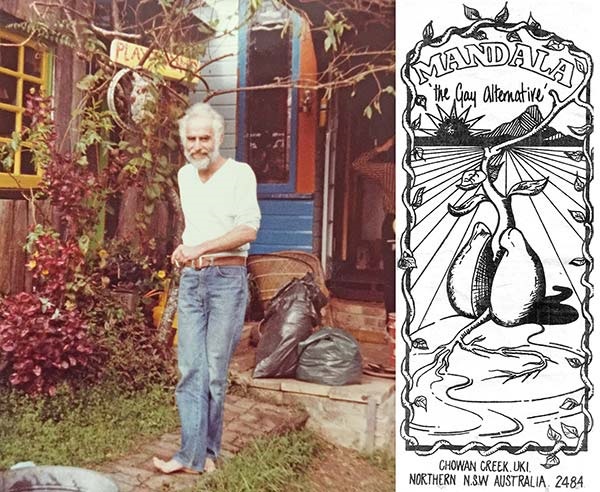 David Johnstone, 1980s and Mandala poster, 1983. David Johnstone Archive, Australian Queer Archives.
David Johnstone, 1980s and Mandala poster, 1983. David Johnstone Archive, Australian Queer Archives.Written by Ian Gray, Curator Northern Rivers Queer History Project.
Australia’s first gay commune was established by David Johnstone in 1973, six kilometres from the village of Uki.
David, a Melbourne television producer/director in the early 1970s, was finding himself fed up with the argy bargy of Australia’s clone-like commercial TV networks. He had been involved in the early counterculture Down to Earth festivals and was lured to head north by the Utopian whispers coming back to chilly Melbourne from the just ended Nimbin Aquarius Festival.
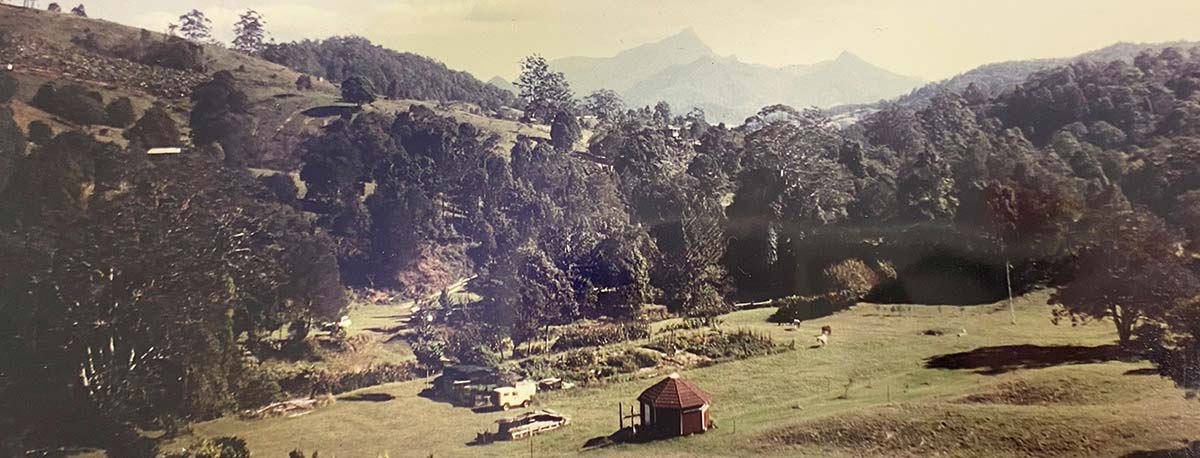
Mandala, 1983. David Johnstone Archive, Australian Queer Archives.
In the beginning
He threw a sleeping bag into his Holden and headed for the North Coast to buy some land and experiment with a rural lifestyle. He set up Mandala near Uki in late 1973 as Australia’s “first piece of rural land owned and run by homosexuals for the benefit of our community”. He envisaged it as a “harmonious, vegetarian and ecologically sound” rural resource centre for gay men and their friends exploring communal living. A safe space for those who needed time for healing; emotional, spiritual and physical.
Left: Horses at Mandala, 1974. David Johnstone Archive, Australian Queer Archives. Right: Summer Dreams gathering, 1983, courtesy of Ian Gray.
The first eight years were hard with small gatherings and long periods of solitude. Lots of friends visited, admired the property, told him what he was doing wrong and headed off to the next adventure. But slowly some friends and locals, both gay and straight, stayed to help with the conversion of an old banana shed into a tiny house, and other infrastructure projects including planting trees, a composting toilet and sauna by the swimming hole.
Tiny house converted from banana shed, 1973. Building the roundhouse, 1984. David Johnstone Archive, Australian Queer Archives.
Planting trees 1981. Building the sauna, 1983. David Johnstone Archive, Australian Queer Archives.
An early gay visitor, Brian Knuckey, who later became a trustee, remembers attending a small gathering in 1974 with 15 mostly local gay men, all excited by his dreams. At times, up to 20 men, women and children shared the land, and sometimes just David and his dog by himself. Brian remembers a couple of other small gatherings in 1977 and 1978 and hearing from David his clear intention to create an “alternative rural space for gays”.
Left: Swimming hole during the 1980s, courtesy of Ian Gray. Right: David Johnstone Archive, Australian Queer Archives.
Left: Outdoor shower and bath, 1980s, courtesy of Ian Gray. Right: Outdoor shower, David Johnstone Archive, Australian Queer Archives.
By 1980, ground down and exhausted by aspects of communal living, he consulted his enigmatic friend, Alice B Wonderful, well known gay miracle worker in Sydney who said, “make a list and call in the poofs”, and so the dream took off again. Working with Sydney gay lawyer John Marsden, he announced the formation of a charitable trust to hold and develop the land as a gay community retreat, managed by the people who live there. He put out the word with numerous articles in the emerging Australian gay press and Friends of Mandala groups in Sydney and Melbourne were formed. Part of the inspiration for David was him hearing about the emerging Radical Faerie gatherings and sanctuaries in the USA through their RFD Magazine.

Summer Dreams gathering at Mandala, 1982-3. David Johnstone Archive, Australian Queer Archives.
The Radical Faeries
 Mud fun at a 1979 gathering at Mandala. David Johnstone Archive, Australian Queer Archives.
Mud fun at a 1979 gathering at Mandala. David Johnstone Archive, Australian Queer Archives.In 1979, Harry Hay and friends, veterans of various phases of US Gay Liberation, issued the call to a “Spiritual Conference of Radical Faeries” in rural Arizona. Hay introduced the idea of merging spirituality into gay liberation, recognising the isolation and disconnectedness that Gay men had grown up with as a spiritual wound needing spiritual healing. The goal of the co-creators of the Radical Faerie movement was to make this spiritual healing possible through various means.
Such seeking led to rural based Faerie Gatherings lasting for a week or more where new and spontaneous ways of relating could emerge, in keeping with the hippie, neopagan, ecological and eco-feminist trends of the time.
Coincidently, in 1980, Ian Gray and Gary Schliemann, gay hippie men living in Sydney in a communal gay house, had also discovered the fledgling Radical Faerie movement in the USA. They attended a few faerie gatherings in the US and returned with a plan to set up a distinct Radical Faerie community in rural Australia.
They saw the “Friends of Mandala” ad in the Gay Community news in 1980 and immediately organised to visit Mandala and together began planning Mandala’s and Australia’s first “Radical Faerie Gathering” which eventually took place in 1982.
Radical Faerie gathering 1982. Spring gathering poster. Radical Faerie circle 1983. Radical Faerie gathering 1984. David Johnstone Archive, Australian Queer Archives.
Six kilometres from the village of Uki, near Murwillumbah, Mandala’s 100 hectares provided a stunningly beautiful sub-tropical environment for the queer community to spend time on a permanent, casual or visitor basis where they and their friends could share their skills in personal and sexual relationships, natural healing, massage, music, art, alternative building and gardening. A safe and fun space of their own.
The 1980s
The 1980s were a busy time for Mandala, with always at least 4-5 permanent residents. The lovely Lemuel was a significant presence for over 10 years from 1982, teaching hundreds of ‘queers’ gardening skills and curing their ills with vile herbal brews and lots of laughter. At its peak, Mandala had over 540 names on its mailing list and quite a profile in the National, Brisbane & Sydney gay press, encouraging capital city folk to visit the “gay alternative”.
Lemuel, 1981. Lemuel’s garden, 1980s. David Johnstone Archive, Australian Queer Archives.
Mandala held several gatherings and events each year throughout the 1980s.
Significant amongst them were the 1982 Easter Country Gathering, Mandala’s first Faerie event and later that year, the Gay Country Carnival, a 10-day closed retreat for gay men, followed by a sports day and a 25th Anniversary celebration of a local gay couple.
1982 Easter Country Gathering. Sports Day, 1982. David Johnstone Archive, Australian Queer Archives.
25th Anniversary celebration at Mandala, 1982. David Johnstone Archive, Australian Queer Archives.
Working with local lesbian, Vera Bourne, Mandala then helped facilitate a week-long Caring & Sharing Retreat for Wimmin & Lesbians, later in January 1983. (The men cleared out of Mandala for a week to the beach).
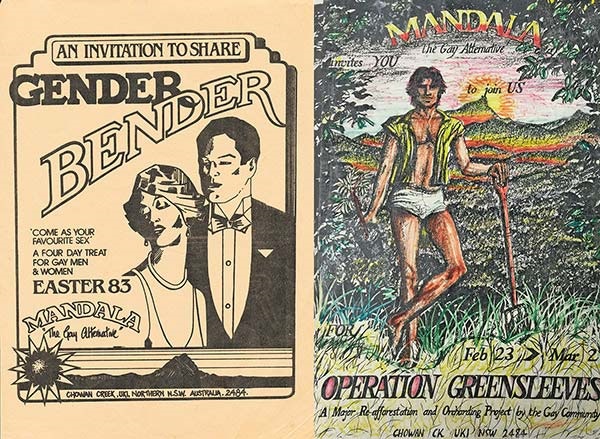 Gender Bender poster, 1983. Operation Greensleeves poster, 1984. David Johnstone Archive, Australian Queer Archives.
Gender Bender poster, 1983. Operation Greensleeves poster, 1984. David Johnstone Archive, Australian Queer Archives.The following Easter, almost 100 gays from all along the east coast, Canberra and Tasmania gathered for Gender Bender, a 4 day feast of fun, workshops and personal growth. “Operation Greensleeves”, a 10-day tree-planting and orcharding workshop and celebration early in 1984 and the “Its Magic Gathering” later in 1984, centred around the Mandala crew attending the controversial 10th National Homosexual Conference in Brisbane.
The Mandala Collective was often busy doing political work away from the land as well. They coordinated over one hundred GLBT folk to attend the 10th Anniversary Alternative Lifestyle Celebration at Nimbin in Sept 1983. Led by David and Lemuel, the collective felt it was important for especially regional Queer folk to explore alternative lifestyles and indirectly reduce their isolation and increase their visibility in the Rainbow Region. They set up a 10m high Pink Triangle Pyramid with workshop spaces, drag wardrobe and kitchen and helped the festival organisers with administration and first aid. On the last night they all frocked up and took to the main stage to add queer faerie magic to the celebration.
The Mandala Collective and pink tent at the 1983 10th Anniversary Alternative Lifestyle Celebration at Nimbin. David Johnstone Archive courtesy of Ian Gray.
Mandala regularly entered several floats in the Sydney Gay and Lesbian Mardi Gras, thus helping remind the queer community that we existed in rural areas too!
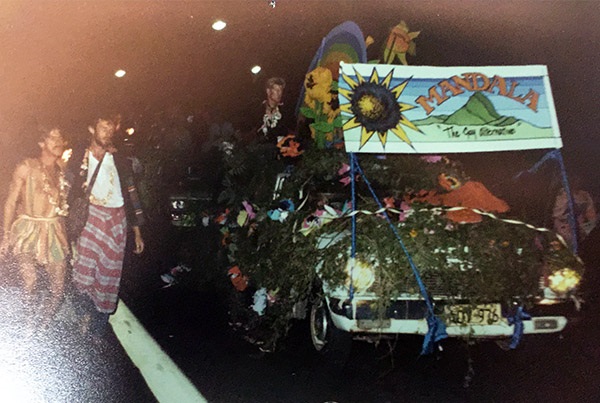 The Mandala float at the 1983 10th Gay and Lesbian Mardi Gras. David Johnstone Archive, Australian Queer Archives.
The Mandala float at the 1983 10th Gay and Lesbian Mardi Gras. David Johnstone Archive, Australian Queer Archives.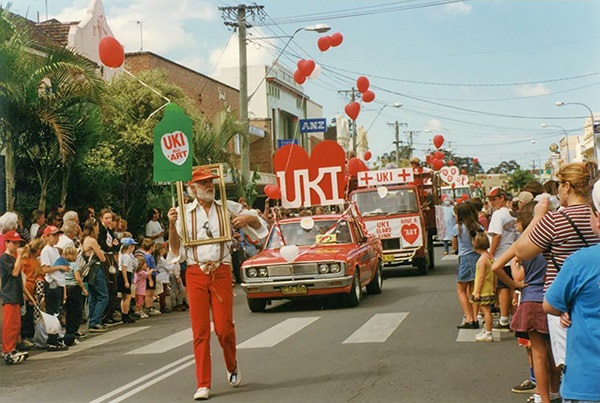 David Johnstone representing Uki in the Banana Festival parade, Murwillumbah, 1997. Tweed Regional Museum Collection US000583.
David Johnstone representing Uki in the Banana Festival parade, Murwillumbah, 1997. Tweed Regional Museum Collection US000583.
David also organised major theatrical musical events for the Tweed Valley community, with the ‘Uki Space Follies’ and ‘Genghis Khan’ musicals becoming local blockbusters with huge casts of local amateurs as keen performers and crews. His community outreach work cemented strong and positive bonds between the local queer and alternative culture and established pioneering dairy and timber families.
The 1990s and 2000s
Up until 1992, when it closed, Mandala was a busy place with over 50 gatherings, workshops and retreats. The networks and friendships of LGBTIQ+ people created by all those who visited Mandala over almost 20 years, were to last to the present. Faeriland Commune Sanctuary, located 40km up the Tweed Valley from Mandala and which became home to the Australian Radical Faeries in 2003, and the larger Radical faerie tribe across Australia, was spawned out of the ground-breaking Mandala experiment.
David sold Mandala in 2000, and eventually re-settled in Cambodia where he passed away in 2017.
Read more about David Johnstone, and Ian Gray.